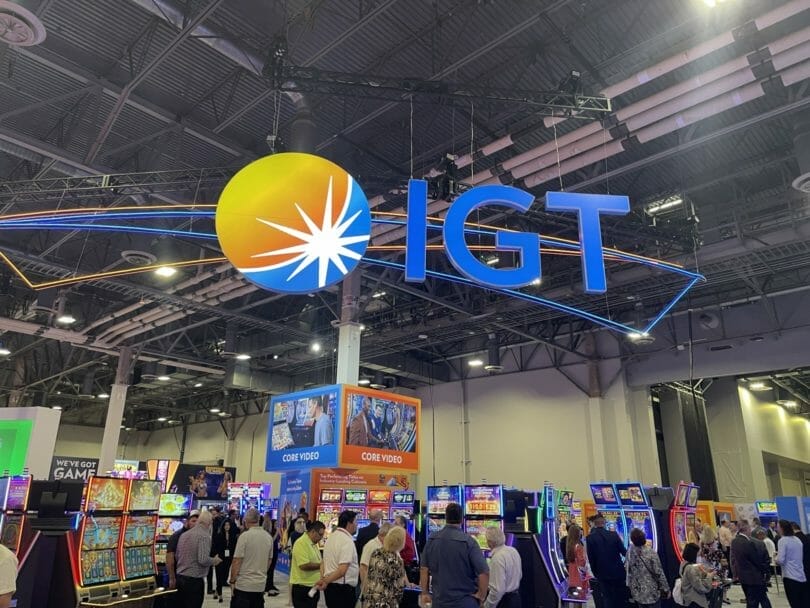As quickly as G2E started, it came to an end! I had intended to do daily updates from the floor, but I was so packed with meetings, especially on Wednesday and Thursday, I didn’t have much opportunity to sit down and actually write much out.
Not to worry, however, as with three days and 55,000 steps under my belt, I’ve accumulated a lot of awesome information that I’ll be sharing in the coming weeks.
I will do manufacturer-specific write ups like I did last year but here are a few observations from this week’s walkthroughs.
Borrowing From Within
Last year, there was a distinct sense of “me too” games from manufacturers trying to do their own variation of another manufacturer’s game type, such as three pot/bag games and Wild Wild games.
While there were still a couple of examples of that this year, the more common scenario was a manufacturer leveraging their own mechanics and mixing and matching them to other game types.
Light and Wonder was showcasing more Explosion and Propserity-series games, and had a unique Ultimate Fire Link Cash Falls mash-up on display too. Aristocrat showcased games that take themes like Chief and Gold Revolution, both initially attached to Buffalo, and extending them to Timber Wolf, just as they did previously with Timber Wolf Gold.
For at least the fourth time, IGT showcased a Wheel of Fortune game that used a previous IGT game, in this case Coin O Mania, and revamped it with a Wheel of Fortune twist.
This seems healthy to me. Players get something a bit familiar, while the games themselves still go in some different directions, so it’s not completely a cloned format. But it lets the companies leverage some of their math that they know works well for players and are successful on the casino floor.
Less Unique Takes, But Good Ones
With all this borrowing and brand extensions, there aren’t as many games cut from new whole cloth, especially from the largest players. But those that were had something interesting going on.
Konami, IGT and Light and Wonder, for example, all had some pretty unique new formats that they were showing off, which should yield some pretty awesome new directions.
Ainsworth has a true Megaways game coming up, as mentioned earlier this week, and Gaming Arts and AGS both had some really interesting stuff on the way as well.
Multi-Denomination Bonanza
Many of the manufacturers that were among the remaining holdouts on a multi-denomination game have begun to make the transition, such as AGS. Light and Wonder had a multi-denomination Quick Hit game on display.
It continues to move in that direction, and it’s all based on player demand. Players want a wide variety of betting options, from the low end to the high end, and so that’s leading to more multi-denomination options.
This yields some interesting changes. For instance, an AGS sequel to River Dragons actually starts with a lower minimum bet than its predecessor, testing my theory on slot sequels. And that Quick Hit game has flat jackpots instead of progressives to avoid the max bet issue that would come up across multiple denominations and so on.
More Open-Ended Bonuses
There seems to be a bit of a trend of doing away with fixed spin counts and such on bonuses and allowing for bonuses to potentially continue on much longer with the right conditions, like landing a prize or so on. Ta-Da Panda is an example I’ve written about, where as long as you land the panda at least once within a three-spin cycle, the cycle resets back to three.
A new Konami game I saw at Resorts World this week offers a cash on reels type bonus that lets you keep spinning for more prizes as long as you win one within a three spin cycle, breaking the standard hold and spin model where you only have so many spaces to win a prize.
These more open-ended formats feel rich with potential, with the flip side that the games are going to be more volatile. In fact, volatility was a continual trend as well, although that’s nothing new, and players are certainly telling me they’re feeling it.
Less Persistence On Display
For the second year, I noticed a relative dearth of games with persistence features. They were definitely out there – IGT, AGS and Everi were among those showcasing games with it – but it did seem to be in different ways than before.
At IGT’s booth there was definitely a give and take in terms of using persistence as a way to encourage players to play, while discouraging outright Advantage Player overruns on the games. A Hexbreak3r sequel was on show but with tweaks that are designed to make the game less of an advantage play. (Interestingly on a volatility scale of 1-6, they had ranked the original a 3 and the sequel more like a 4.5.)
Another game they showcased, Fortune Magnet, had prizes that could persist for some period of time to be won before being taken away, but it is not a fixed amount of time and so it creates a new wrinkle.
Everi was showcasing a simple persistence feature on a new mechanical reel game where pays can be doubled for a few bought spins. AGS had something much more complex on show, with a mechanic that reminded me a bit of Devils and Diamonds Deluxe, a game I haven’t written up yet here but also has a more complex persistence aspect.
More to Come
Along with the full write-ups of the booths I was able to tour this year, I also filmed two videos, one with Light and Wonder and another with Ainsworth. I’ll be sharing those along with more of what I learned at the show!







